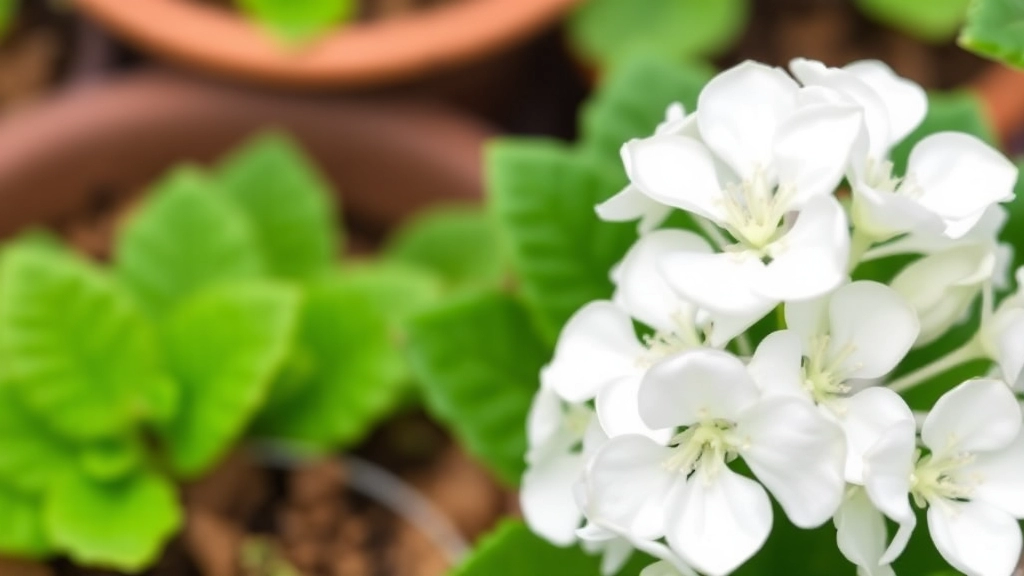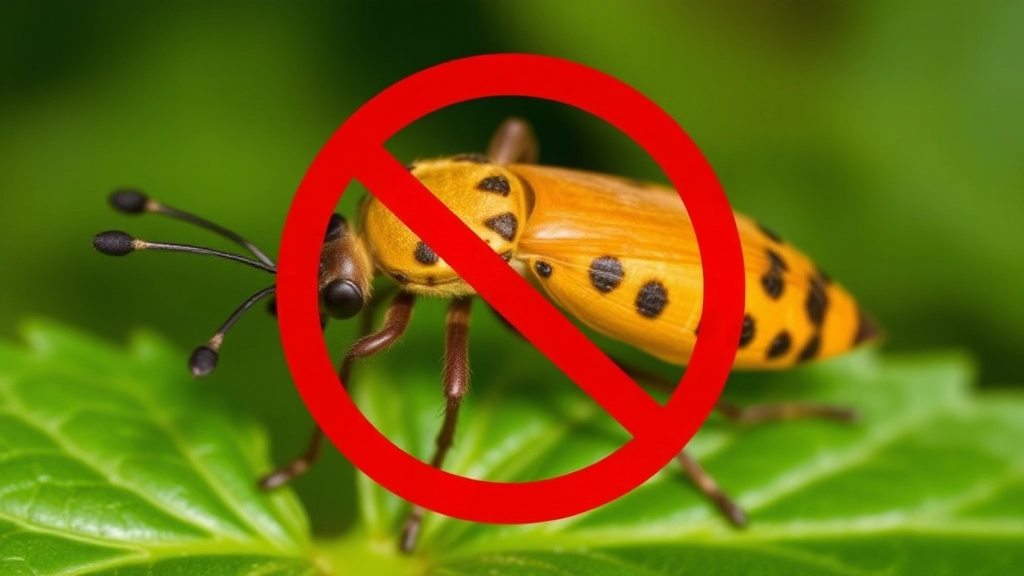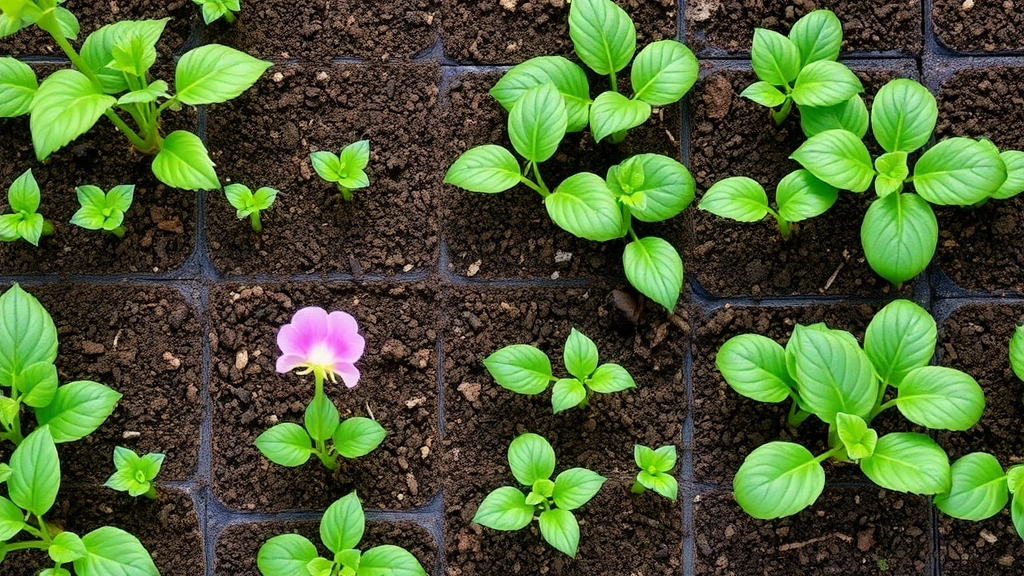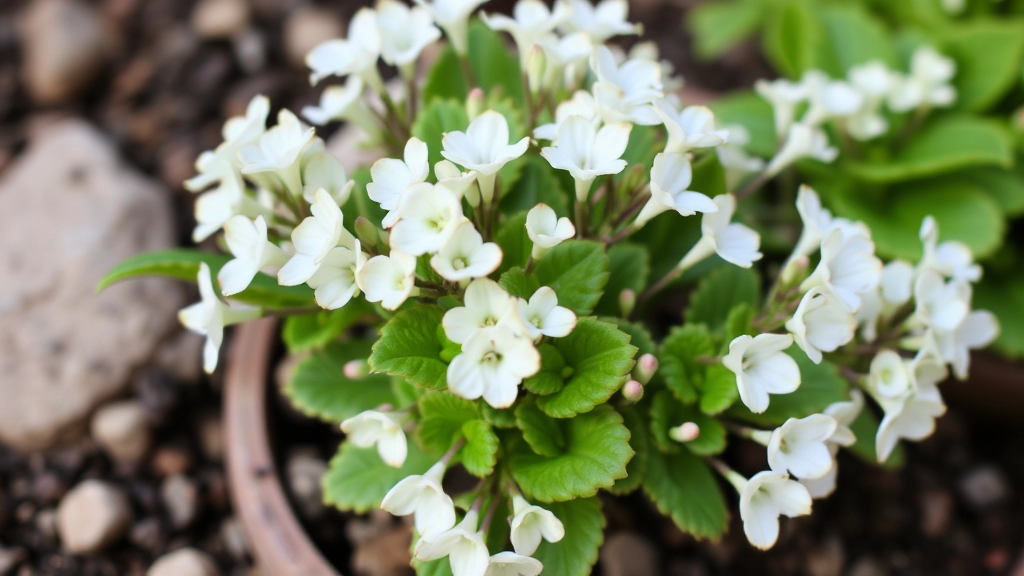Welcome to White Kalanchoe Plant Care
Hey there! If you’re looking to add a touch of elegance to your home, the White Kalanchoe Plant is a fantastic choice. This resilient succulent not only brightens up your space but is also super easy to care for.
Stick around as I guide you through the essentials of nurturing your White Kalanchoe Plant, ensuring it thrives and stays vibrant all year round. Let’s dive in!
Characteristics of the White Kalanchoe Plant
When considering houseplants, many people seek options that are both beautiful and easy to care for. The White Kalanchoe plant is a prime example of such a choice.
This succulent is known for its striking white flowers and fleshy green leaves.
Key Features:
- Flowers: The White Kalanchoe produces clusters of small, delicate white blooms. These flowers can brighten up any space and typically appear in late winter to early spring.
- Leaves: Its leaves are thick and glossy, often with a slight reddish tint at the edges. This unique coloration adds visual interest to the plant.
- Size: Generally, the plant grows to about 30-45 cm (12-18 inches) in height, making it suitable for both tabletops and larger spaces.
- Lifespan: With proper care, a White Kalanchoe can live for several years, providing ongoing beauty and enjoyment.
The White Kalanchoe is not just visually appealing; it is also resilient and adaptable. For those interested in more detailed care instructions, you might find our Ultimate Guide to Caring for Kalanchoe Flaming Katy Houseplant helpful. Additionally, understanding the Maximum Size of Kalanchoe can provide insights into how large your plant might grow and how to manage its growth effectively.
Ideal Growing Conditions for White Kalanchoe

So, you’ve got your heart set on a White Kalanchoe, but where do you start?
Understanding the ideal growing conditions is key to keeping your plant thriving.
Light Requirements
White Kalanchoe loves bright, indirect sunlight.
- Best Spot: A south or west-facing window is perfect.
- Avoid Direct Sun: Too much direct sunlight can scorch the leaves.
Temperature Preferences
This plant thrives in a warm environment.
- Ideal Range: Keep it between 18-24°C (65-75°F).
- Watch Out for Cold: Avoid temperatures below 10°C (50°F) as it can stress the plant.
Humidity Levels
Kalanchoe isn’t too picky about humidity, but a little extra moisture can help.
- Average Humidity: It does well in average household humidity.
- Dry Air Caution: If your home is super dry, consider misting occasionally.
Soil Type
The right soil can make all the difference!
- Well-Draining Soil: Use a cactus or succulent mix.
- pH Level: Aim for a slightly acidic to neutral pH (6.0-7.0).
Potting Considerations
The pot you choose matters too!
- Drainage Holes: Always opt for pots with drainage holes to prevent root rot.
- Size Matters: A pot that’s too big can hold excess moisture, so choose one that’s just right.
Watering and Fertilization Needs
When it comes to caring for your White Kalanchoe, understanding its watering and fertilization needs is crucial. Many plant enthusiasts often wonder how to strike the right balance without over or underdoing it.
Watering Needs
The White Kalanchoe thrives in well-draining soil, which means its watering requirements are somewhat unique. Here are some key points to consider:
- Frequency: Water your Kalanchoe when the top inch of soil feels dry. This typically translates to once every 1-2 weeks, depending on your climate.
- Method: Water thoroughly until you see excess draining from the bottom. This ensures the roots receive adequate moisture without sitting in water.
- Signs of Overwatering: Yellowing leaves or mushy stems can indicate you’re watering too much. If you notice these signs, reduce your watering frequency.
- Signs of Underwatering: If the leaves start to wrinkle or become crispy, it’s time to give your plant a drink.
Fertilization Needs
Fertilizing your White Kalanchoe can significantly enhance its growth and blooming potential. Here’s how to do it effectively:
- Type of Fertilizer: Use a balanced, water-soluble fertilizer, such as a 10-10-10 formula. This provides essential nutrients without overwhelming the plant.
- Frequency: Fertilize every 4-6 weeks during the growing season (spring and summer). In autumn and winter, cut back on fertilization as the plant enters dormancy.
- Dilution: Always dilute the fertilizer to half the recommended strength to avoid burning the roots.
In summary, proper watering and fertilization are vital for a thriving White Kalanchoe. By following these guidelines, you can ensure your plant remains healthy and vibrant. For more detailed information on why your Kalanchoe is not flowering and how to fix drooping Kalanchoe leaves, be sure to check out our other guides.
Common Pests and Diseases

When nurturing your White Kalanchoe, it’s essential to be aware of the common pests and diseases that can threaten its health.
What pests should I look out for?
- Aphids: These small, sap-sucking insects can cause leaves to curl and yellow.
- Mealybugs: Often found in clusters, they appear as white, cottony masses on the plant.
- Spider Mites: These tiny arachnids create fine webs and can lead to leaf discoloration.
- Scale Insects: They attach themselves to the stems and leaves, appearing as small, brown bumps.
What diseases can affect my Kalanchoe?
- Powdery Mildew: This fungal disease manifests as a white powdery coating on leaves, often due to high humidity.
- Root Rot: Caused by overwatering, this leads to wilting and yellowing leaves, and ultimately, plant death if not addressed.
How can I manage these issues?
- Regular Inspections: Check your plant weekly for any signs of pests or disease.
- Neem Oil: A natural insecticide that can help control pests without harming the plant.
- Proper Air Circulation: Ensure your Kalanchoe has enough space to breathe, reducing humidity and preventing mildew.
- Watering Practices: Water only when the top inch of soil is dry to prevent root rot.
Pruning and Maintenance Tips for White Kalanchoe
Maintaining the health of your White Kalanchoe plant is essential for its vibrant blooms and overall vitality. You might be wondering how to keep it looking its best, especially if you’re new to plant care.
Propagation Methods

So you’re keen on spreading the joy of your White Kalanchoe? That’s fantastic! Propagating this lovely plant is pretty straightforward and can be a rewarding experience.
Here’s how you can do it:
Leaf Cuttings
- Select a healthy leaf: Choose a plump leaf from your parent plant.
- Cut the leaf: Use a clean, sharp knife to take a cutting. Aim for a leaf that’s at least a few inches long.
- Let it callous: Place the cutting in a dry spot for a couple of days. This helps prevent rot.
- Plant it: Once the cut end has calloused, stick it in well-draining soil. Water lightly until roots develop.
Stem Cuttings
- Choose a stem: Look for a healthy, non-flowering stem.
- Make the cut: Cut just below a leaf node.
- Callous time: Let it dry for a day or two.
- Pot it up: Place the cutting in soil, ensuring the node is buried. Water gently.
Offsets
- Find offsets: These are small plants that grow around the base of the parent plant.
- Gently remove: Use your hands or a small tool to separate the offsets from the main plant.
- Replant: Place them in their own pots with fresh soil.
Tips for Success
- Light: Keep your cuttings in bright, indirect light.
- Humidity: A humidity dome or plastic bag can help retain moisture.
- Patience: Roots can take a few weeks to develop, so don’t rush the process!
Benefits of Growing White Kalanchoe
As we explore the advantages of cultivating the White Kalanchoe, it’s important to consider why this plant has become a favourite among both novice and experienced gardeners.
Aesthetic Appeal
One of the most immediate benefits of the White Kalanchoe is its stunning appearance.
- Vibrant Blooms: The plant boasts clusters of delicate white flowers that can brighten any space.
- Versatile Decor: It fits seamlessly into various interior styles, from modern to traditional.
Low Maintenance
For those who may worry about time-consuming plant care, the White Kalanchoe is a perfect choice.
- Drought Tolerant: Its succulent nature means it requires less frequent watering.
- Resilient: This plant can thrive in less-than-ideal conditions, making it forgiving for busy lifestyles.
Health Benefits
Beyond aesthetics, growing White Kalanchoe can contribute positively to your well-being.
- Air Purification: Like many houseplants, it can help improve indoor air quality.
- Stress Relief: Engaging with plants has been shown to reduce stress and enhance mood.
Educational Opportunities
Cultivating White Kalanchoe can also serve as a fantastic learning experience.
- Understanding Plant Care: It provides a hands-on opportunity to learn about succulent care and propagation.
- Inspiring Creativity: Designing arrangements or selecting pots can unleash your creative side.
Gift Potential
This plant makes for an excellent gift, suitable for various occasions.
- Symbol of Love: Its beauty and longevity can convey heartfelt sentiments.
- Easy to Share: Its propagation methods allow you to share cuttings with friends and family.
Frequently Asked Questions
When it comes to the White Kalanchoe plant, I often get asked a bunch of questions.
Here are some of the most common ones that might just pop into your mind:
1. How much sunlight does the White Kalanchoe need?
The White Kalanchoe loves bright, indirect sunlight.
Too much direct sun can scorch its leaves, while too little can stunt its growth.
2. How often should I water my White Kalanchoe?
Watering is crucial for this beauty.
- Let the soil dry out completely between waterings.
- Generally, once every two weeks is a good rule of thumb, but it can vary based on your environment.
3. Is the White Kalanchoe toxic to pets?
Yes, it can be toxic to pets if ingested.
It’s always best to keep your plants out of reach if you have curious furry friends around.
4. What’s the best fertilizer for White Kalanchoe?
Look for a balanced, water-soluble fertilizer.
- A 10-10-10 formula works wonders.
- Fertilize every month during the growing season for best results.
5. How do I know if my plant is getting too much water?
Yellowing leaves are a telltale sign of overwatering.
If the leaves feel mushy, it’s time to cut back on the watering.
6. Can I propagate my White Kalanchoe easily?
Absolutely!
You can propagate it through leaf or stem cuttings.
For a detailed guide, check out our step-by-step guide on propagating Kalanchoe.
7. When is the best time to prune my White Kalanchoe?
Pruning is best done in the spring.
This encourages new growth and keeps your plant looking tidy.
8. How long will my White Kalanchoe bloom?
With the right care, it can bloom for several weeks.
For more tips on keeping your blooms vibrant, visit our care tips for vibrant Kalanchoe blooms.
FAQs About White Kalanchoe Plant
What kind of light does a White Kalanchoe need?
The White Kalanchoe thrives in bright, indirect sunlight. A south or west-facing window is ideal, but be cautious of direct sunlight as it can scorch the leaves.
What is the ideal temperature range for a White Kalanchoe?
This plant prefers a warm environment, ideally between 18-24°C (65-75°F). Avoid exposing it to temperatures below 10°C (50°F) to prevent stress.
Does White Kalanchoe require high humidity?
White Kalanchoe does well in average household humidity. If your home is particularly dry, consider misting the plant occasionally to provide extra moisture.
What type of soil is best for White Kalanchoe?
Use well-draining soil, such as a cactus or succulent mix. Aim for a slightly acidic to neutral pH level, around 6.0-7.0.
What kind of pot should I use for my White Kalanchoe?
Choose a pot with drainage holes to prevent root rot. Ensure the pot size is appropriate; too large a pot can hold excess moisture.
What pests commonly affect White Kalanchoe?
Common pests include aphids, mealybugs, spider mites, and scale insects. Regular inspections can help you catch these pests early.
What diseases should I be aware of?
White Kalanchoe can be affected by powdery mildew and root rot. Powdery mildew appears as a white powdery coating on leaves, often due to high humidity. Root rot is usually caused by overwatering.
How can I manage pests and diseases?
Regularly inspect your plant for signs of pests or disease. Use neem oil as a natural insecticide, ensure proper air circulation, and water only when the top inch of soil is dry to prevent root rot.
How can I propagate my White Kalanchoe?
You can propagate White Kalanchoe through leaf cuttings, stem cuttings, or offsets. Each method involves selecting healthy parts of the plant and allowing them to callous before planting in well-draining soil.
What are some tips for successful propagation?
Keep your cuttings in bright, indirect light and consider using a humidity dome or plastic bag to retain moisture. Be patient, as roots can take a few weeks to develop.
References
-
The Spruce – Growing Kalanchoe Plants
-
Gardening Know How – Kalanchoe Care
-
The Old Farmer’s Almanac – Kalanchoe
